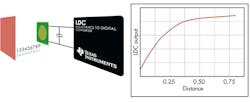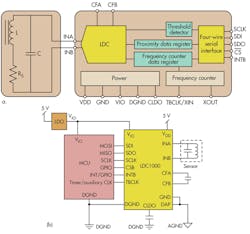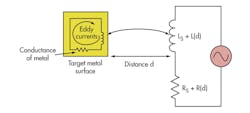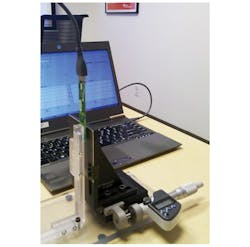Don’t be fooled by the simple name. The Texas Instruments LDC1000 inductance-to-digital converter is the most sensitive and versatile position-sensing technology ever offered. It could even be called the death knell for Hall effect sensing as it measures the de-tuning effects of nearby conductors on LC tank circuits (Fig. 1).
Typically, the coil in the tank is an external planar helix on a printed-circuit board (Fig. 2). Calibrated to read out changes in the coil’s inductance to 24-bit precision, the LDC1000 drives and monitors the tank. The drive frequency, which determines the dimensions of the coil to some extent, can be anywhere from 5 kHz to 5 MHz.
Applications
The LDC1000’s target applications all involve position sensing, particularly industrial, though medical and automotive also represent significant uses. Over the past decade, automobile makers have replaced virtually every mechanical position sensor with Hall effect sensors, which have become as cheap as mechanical limit switches and offer orders of magnitude greater reliability.
This file type includes high resolution graphics and schematics when applicable.
There’s one problem with limit switches and Hall effect sensors, though. Their output is binary. They’re open or closed. That’s fine for sensing that the rear hatch is closed. They can even tell an engine control unit (ECU) that the shift lever is in drive, neutral, or reverse. But they can’t resolve throttle or brake-pedal displacement. The LDC1000 can.
In addition, the LDC1000 technology isn’t limited to precise measurements of linear displacement. Remember that planar inductor? Imagine what happens when a coaxially mounted metal disc gradually occludes it. The LDC1000 yields the same 24-bit precision for angular displacement as it does for linear displacement.
If that precision is repeatable, then, is it even usable? Texas Instruments says that an apparatus using the LDC1000 placed under a hospital bed can detect a patient’s breathing rate. Texas Instruments aims to increase its sensitivity and false detection software to enable it to monitor heart rate from under a mattress as well.
Why It Works
Based on practical experience, most engineers will accept that bringing their hand near a tuned circuit will de-tune it. It may be a little harder to accept the idea that the effect is consistently repeatable, much less repeatable to 24-bit precision.
An ac current in a coil will generate a field that causes eddy currents in nearby conductors. The eddy currents depend on the distance, size, and composition of the target conductor. In turn, the eddy currents then generate their own field, which opposes the field around the coil.
Consider the exciting coil the primary of a transformer and the external conductor a secondary, with some arbitrary L and R losses. Like all transformers, this one is passive and bilateral. It’s also a parallel LC tuned circuit. That’s where the original ac signal that’s exciting the eddy currents in the “secondary” piece of metal is coming from. (Fans of Nicola Tesla should be starting to smile.)
Then, the LDC1000 measures the equivalent parallel resonance impedance, Rp, where:
Rp(d) = (1/([Rs + R(d)]) × ([Ls + L(d)])/C
The d designation indicates that those variables are functions of the distance to the disturbing conductor(Fig. 3).
The LDC1000 works by simultaneously measuring the impedance and resonant frequency of the external LC resonator that it’s driving. It does this to regulate the oscillation amplitude to a constant level while monitoring the energy dissipated by the resonator. By monitoring the amount of power injected into the resonator, it calculates the value of Rp. Also, measuring the oscillation frequency of the LC tank circuit determines the inductance of the helical coil in the LC circuit. Rp and frequency are output as digital values.
In addition to providing for oscillation frequencies from 5 kHz to 5 MHz, the value of Rp can theoretically range from 798 Ω to 3.93 MΩ. In practice, though, a circuit designer would select from a tighter range and enter those values in a pair of registers.
Demo Board
Naturally, there is a demonstration kit (Fig. 4). Its fiber reinforced plastic (FRP) demo board is a USB stick that could plug right into a desktop computer. Below that, and firmly mounted to a robust pivot assembly, is a metal plate that can be moved toward or away from the tank coil by a pivot assembly that can be displaced forward and backward by the digital-readout caliper.
About the Author

Don Tuite
Don Tuite (retired) writes about Analog and Power issues for Electronic Design’s magazine and website. He has a BSEE and an M.S in Technical Communication, and has worked for companies in aerospace, broadcasting, test equipment, semiconductors, publishing, and media relations, focusing on developing insights that link technology, business, and communications. Don is also a ham radio operator (NR7X), private pilot, and motorcycle rider, and he’s not half bad on the 5-string banjo.





